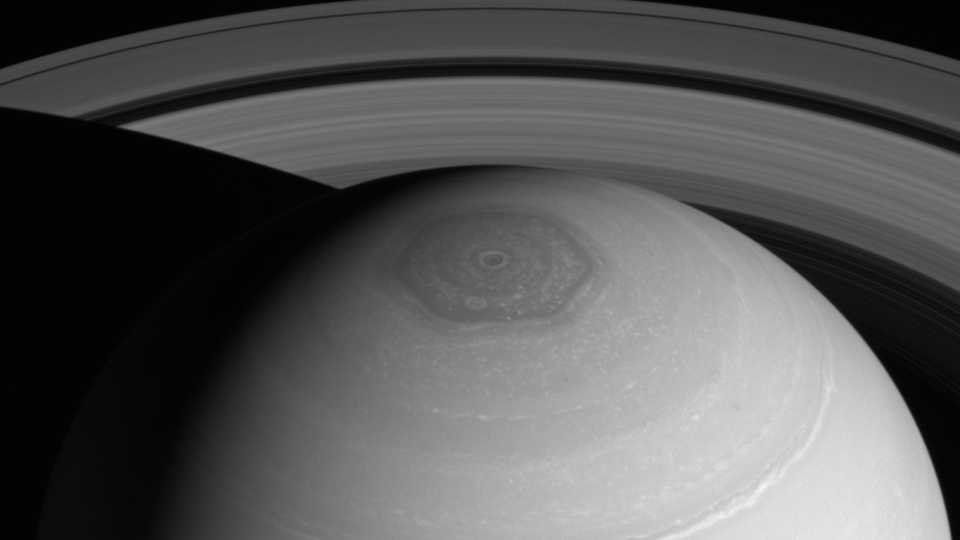Universe Update
The Many Tempests of the Ringed Giant

While Cassini has made groundbreaking discoveries observing Saturn’s menagerie of moons and its incredible ring system (which we’ll talk about Friday), most of Cassini’s time has been spent staring at the gas giant’s atmosphere.
One of the most surprising and awe inspiring discoveries was Saturn’s Northern Polar Hexagon. First spotted by Voyager in the 1980’s, the hexagon was a truly odd sight: a massive storm several times larger than the entire planet Earth, bordered by six well-defined sides. The hexagon is likely the largest polygon ever observed in nature, and has no analog on Earth, or anywhere else currently known.
When Cassini arrived at Saturn in 2004—over 20 years after Voyager—not only did it confirm the hexagon was an enduring feature, but by regularly keeping an eye on it, the spacecraft was able to track how the storm changes over time. Cassini’s frequent observations allowed scientists to generate animations of the storm, and show how it changed composition and color. Over its extended mission, Cassini has captured countless breathtaking images of the hexagon, each of them stunning in their own right, and all begging the obvious question: Why is there a giant hexagon on Saturn?
In 2010 a research group made a significant step towards solving this perplexagon by creating a similar looking hexagon in their lab; by directing fluid streams of varying speeds in particular patterns, they were able to form several different polygons, including a hexagon. This suggested that jet streams in Saturn’s atmosphere drive the storm’s winds, while also defining sharp borders that contain it. Although similar in structure, the lab-made hexagon formed many smaller vortices bordering the polygon’s edges, which Saturn’s storm lacks, leaving the mystery only partially solved. More recent research may have worked out some of the finer points.
Looking at the opposite side of the planet, although the south pole lacks a hexagon of its own, it is home to another large vortex and brilliant aurora. These auroras, much like those seen on Earth, are driven by interactions between the planet’s magnetic field and high energy particles ejected by the Sun. Unlike Earth, Saturn’s field is highly complex due to influences from its moons, and the auroras are strong enough to have their light peak in high-energy, ultraviolet wavelengths. Not only could further study of these dazzling light shows help us improve our understanding of Saturn’s internal structure, but it may also give more context for how’s Earth’s own magnetic field functions.
Not to be outdone by its poles, the rest of Saturn is no slouch when it comes to storms either. Starting in 2010, Cassini was able to capture images of one of the largest storms ever observed. Although this somewhat periodic storm system had been observed several times, dating back over 100 years, Cassini gave an unprecedented detailed look at the event. The storm raged for seven months, growing and spreading around the globe until eventually it grew so large that the tail of the storm met with its head, like a meteorological ouroboros, eventually tearing itself apart. Cassini’s instruments were focused on the storm, capturing data and recording how the atmosphere was changed by the maelstrom as it rolled through: the high wind speeds dredged up gases previously trapped deeper within Saturn, exposing them to radiation and thereby modifying the molecular composition of the planet’s outer layers. Cassini’s radio receivers were even able to detect lightning strikes all throughout the storm, some of them ten thousand times more powerful than those seen on Earth. Cassini’s observations of the storm gave astronomers a unique opportunity to gaze closer and deeper into Saturn’s interior than ever before, helping to confirm previous theories about atmospheric composition and give a better understanding of its flow.
As Cassini continues its Grand Finale and eventual descent toward Saturn’s atmosphere, it leaves behind an incredible legacy spanning more than a decade of scientific discovery. Be sure to check back at the end of the week for the last of our articles celebrating the historic spacecraft as we talk about Cassini’s up close encounters with Saturn’s iconic rings.